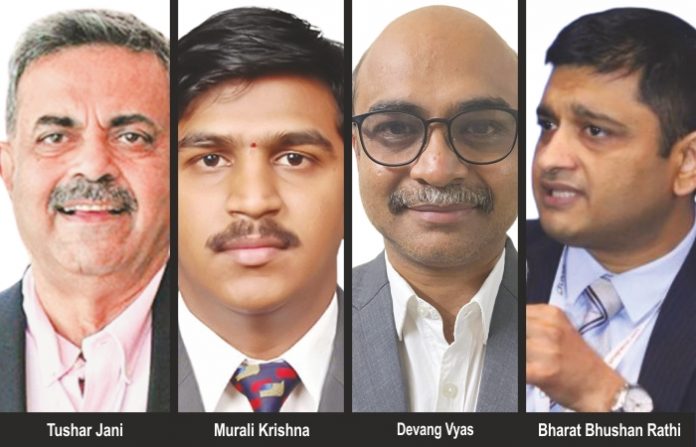CARGOTALK in collaboration with Cargo Service Centre conducted Pharma Talkathon Part 3 Digital Conclave on ‘Can India grow its global market share of generic drugs by 40%?’ recently. The webinar focused on various aspects of pharma exports such as infra for manufacturing pharma in India, availability of raw materials, dependency on other nations, skilled manpower, recent advancements, and investments in improving digital infra for pharmaceuticals, pain points, role of technology to maintain the integrity of temperature-sensitive shipments and lot more. The key speakers included Tushar Jani, Group Chairman, Cargo Service Center, Murali Krishna, Director, Pharmexcil, Devang Vyas, Global Logistics Head at Glenmark Pharmaceuticals and Bharat Bhushan Rathi, Head, Distribution and Logistics, Mankind Pharma, while the discussion was moderated by San Jeet, CEO, DDP Group. The discussion generated a lot of impact and saw great participation from the industry.
Tushar Jani, Group Chairman, Cargo Service Center
Affordable pharma prices key to increase global market share
India is a global pharmacy. I think 20 per cent for the start is also good. I feel this market share is going to grow. Our products are accepted and being consumed globally. If you look at one trillion target of merchant exports, it is 57 billion alone which comes from pharmaceuticals and that is a great news.
The only challenge is Active Pharmaceutical Ingredient (API) for which we are dependent on China, and we must figure out how we can become self-sufficient. Our second innovation comes in terms of packing material, we need to make more sustainable packing material, India should take the lead in developing packing material to remove the dry ice which is actually against the environmental issue. Thirdly, there should be an emphasis on research, and fourth is that we need to develop an eco-system for pharma e-commerce for transportation of generic drugs out of India, for this we have distribution centres across the globe—in the USA, Europe, Far East, Africa and in many other countries, but we need to expand our international reach and presence. India should become global pharma e-commerce leader to have a greater market penetration and that should be the goal.
The challenge right now is the shortage of skilled manpower in the industry because the standards are going to be high in the coming years and free trade agreements (FTAs) are making standards tough. So, the ecosystem needs to be created for more skilled manpower. There should be more cohesiveness between the industry and its stakeholders. Industry stakeholders involved in maintaining resilient pharma supply chains should collaborate with each other.
Indian drugs should reach customers internationally at a reasonable price and that should be the key to increase global market share. Freight rates go high when demand increases and that is the main challenge. At present, we have great cold storage infrastructure for handling and transporting temperature-sensitive products. If everything gets in place, we can achieve the said target in seven years.
Murali Krishna, Director, Pharmexcil
India imports 60-70% pharma raw materials
During FY2022-FY2023, we touched US$25 million, 3.5 per cent growth in the pharma sector. These are important figures for the Indian pharma sector. Almost 5.6 per cent of the merchandise trade is from the pharma sector. Pharma is the third largest principal commodity for exports to other countries.
If you look at the category contribution for finished goods formulations, it is the one contributing 72 per cent followed by 18 per cent, which is contributed by generic drugs and herbals. I would say, India has made a significant presence in the global pharmaceuticals market.
The journey started with import dependence with export surplus, and the country is going forward with India being known as pharmacy of the world. In terms of raw materials and required capabilities, we have the required resources, infrastructure, and capabilities. But when it comes to raw materials, the dependence on other countries for raw material is up to 60-70 per cent.
Raw material comes from China and some chemicals from South Korea, Taiwan, and Japan. During COVID, India proved its capabilities. The world now knows India not only as a global producer of generic drugs, but also as innovative vaccine producer—producing Covaxin and Covishield in huge quantities and supplying the same worldwide. Pharmexcil took it as its mandate and tied up with Intelligent System Emulation Technology (ISET), ISSAR Pharma, CSNG Pune, Dr. Reddy’s and various other labs to conduct a study to evaluate percentage of dependency for raw materials on other countries and how to overcome it and how the raw materials could be produced indigenously in India. The results suggested by Pharmexcil report have been considered by Indian pharma authorities and the Govt of India as a cue for PLI scheme. We have the products in hand and to scale up new products, it takes a minimum of 2-3 years. Since China is scaling up manufacturing and its prices going down, we be careful.
Regulatory procedures are the only concern if India wants to increase its exports. In this regard, Pharmexcil has developed regulatory practices of top 30 countries and its available for industry view on our website. In April 2023, we had 6,316 USFDA market authorisations, we had 300 cite approvals, and 58 formulations approvals. We have infrastructure in place, manufacturer should be conscious enough about classifying the storage vehicles, according to the variety of pharma drugs available.
Devang Vyas, Global Head of Logistics, Glenmark Pharmaceuticals
India must boost raw material production
The recent global constraints such as Russia-Ukraine conflict, shortage of US$ reserves in African countries, global slowdown among others have affected pharma exports globally, and impacted trade from India, but business is shaping up well in India for pharma.
Apart from Russia-Ukraine conflict, there are many other global challenges, which disrupted the supply chain, but overcoming all the hurdles that we had few months ago such as availability of vessels, documentation, payments among others—India is supplying pharma to Russia efficiently. But we must be resilient and well-prepared for the challenges that may come such as oil prices. It was easy for Indian pharmaceuticals to deal with crises such as shortage of US$ reserves, devaluation of US$ in Africa from past one decade, because of availability of medicines and country’s purchasing power.
Indian pharma manufacturers are supplying medicines in over 18 countries. Crucial pain points will remain dependency on China, we need to become sustainable, API manufacturers need to enhance their capacities looking at the surge in demand. Pharma is the only one industry which involves a lot of regulatory procedures, the industry works towards achieving highest benchmark globally, setting high standards.
India, known as the pharma hub of the world, has been supplying the pharma across the globe since the past many years. This acceptability shows how resilient we are, what skillsets, facilities, infrastructure, support we have, in ensuring the medicines consumed globally are of the highest standards and cost-effective. As an industry, we need to focus on having adequate raw materials, highest pharma standards, have regular audits, create more training and awareness, address shortage of skilled manpower, and adhere to strict safety protocols to ensure the quality of pharma being manufactured.
Knowledge Transfer from large established manufacturers about international quality standards for small and mid-sized companies is required. Patient safety is an area why large firms have started to implement pharmacovigilance cell to deal with complaints.
Bharat Bhushan Rathi, Head, Distribution and Logistics, Mankind Pharma
Digital infra must for pharma industry
Technology plays a crucial role in ensuring cent per cent integrity of pharma products, and efficacy, resiliency, and agility of pharma supply chain. Technological integration is crucial for entire logistics ecosystem. The government is taking various initiatives to boost tech adoption in pharma manufacturing and logistics business, but the industry should also play its part. An ecosystem should be created where all the stakeholders associated with the pharma industry can work together under the PPP model. First is the manufacturer who is taking care of the raw materials available for producing pharma, second is the infrastructure for pharma logistics, everyone today wants sasta, sundar and tikau—cost-effective and affordability of prices without compromising on quality of products.
Since we are talking about pharma cross border e-commerce from India, quality, time, and cost should be taken into consideration. When we talk about our logistics ecosystem through ports and airports, we still see a lot of manual work happening; there is a need to cut down on manual operations.
There is also a need to invest more in digital infrastructure by the government as well as private players for warehouses, ports, airports, paperless and seamless transactions such as Bill of Entries, at gateways so that shipper or customers can easily take their shipments. This can cover risks which may occur during pharma supply chain. We are on the right track, growing from compound annual growth rate of 8-10 per cent in the past one decade and we can achieve a higher percentage by 2030. India has a robust manpower which should be used in a right way with tech advanced equipment.















